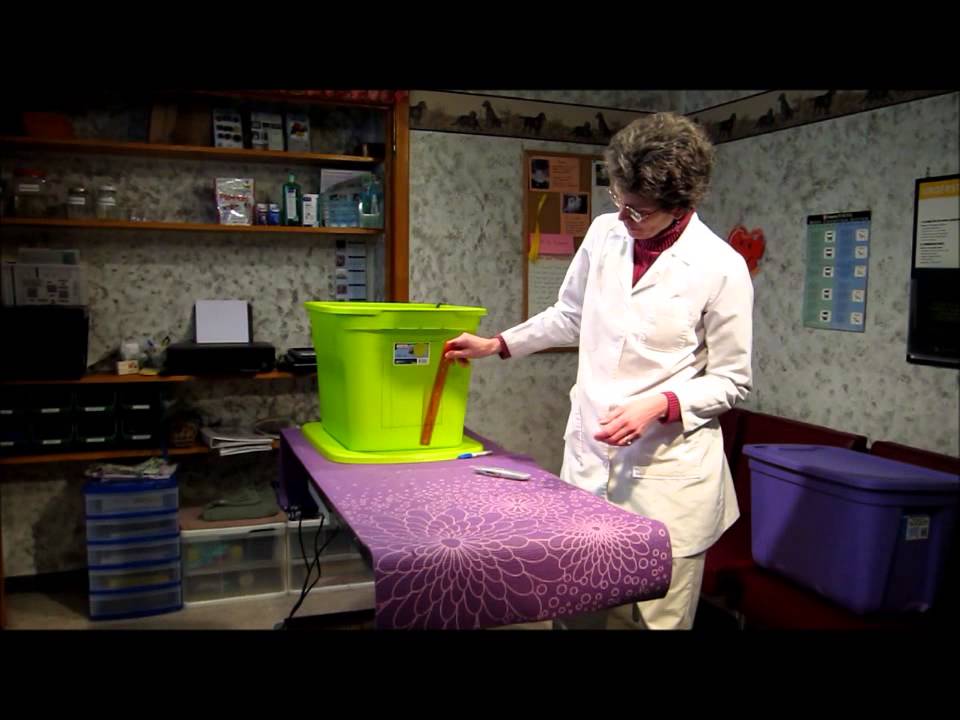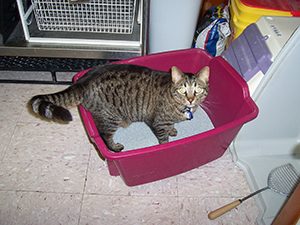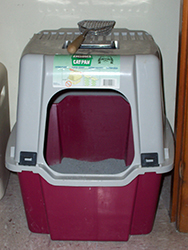One of the leading complaints from cat owners is elimination outside of the litter box. Dr. Nicholas Dodman DVM, ACVB, of the Animal Behavior Clinic at Tufts University, reports up to 4% of cats in United States Households (3 million out of 75 million) urinate outside of the litter box weekly, with 1% urinating daily outside of the box. Up to 24% of all cats will have litter box aversion at some point in their life. Litter box aversion, or inappropriate elimination, can involve urination, defecation or both. It can be either a consistent or occasional problem. You may see the cat use the box for either stool or urine, but not both, and they may use the box, then “out of the blue,” not. The damage, smell, and distress of this behavior problem is serious. Many cats are surrendered, re-homed, or euthanized due to this problem. It is difficult to find data on rates of behavior problems in cats surrendered or re-homed since often people will not report this, or will under report this upon surrender. Some cats are turned outside due to this problem and may then be picked up as a stray.
There can be a number of medical, environmental, and behavioral factors that contribute to litter box aversion. I am going to cover some of the most important factors to address in helping a cat be happy about their litter box.
How can you keep your cat happy with the litter box?
Here are some of the most important factors for keeping a cat happy with the litter box at various life stages:
Make it easy for the cat to get into the box.
This may sound obvious, but most of the commercial litter boxes are not easy for cats to use. For example, if a kitten gets a litter box that is 6 inches or more in height to enter, it might be difficult for it to get into. So the kitten may start using the carpet or clothing to urinate on just to be able to relieve itself. Now the kitten is learning to prefer carpet or clothes at this early stage in life.
Older cats often have arthritis. In an FDA report by Dr. Carmela Stamper, DVM, (Osteoarthritis in Cats: A More Common Disease Than You Might Expect) there is a range from 28% of cats having arthritis in the elbow and skeletal joints up to 90% of cats with arthritis in the spine and body. This pain and inflammation makes it more difficult to get into a box. Again, our commercial boxes with high sides makes it difficult to enter so the cat has no choice but to go elsewhere. Also, this arthritis in the spine can slow the bowels down, aggravating constipation. So a cat may go in the box and try, but nothing happens. After a few minutes out of the box now they have the urge and may not be able to get to the box in time.
In general most cats like a box that they can walk right into with an entry lip no higher than 3 inches.
Finding a box like this to purchase is not easy. Litter box manufacturers have not kept up with feline behavior and preferences, so it might be best to make your own. The best litter box I have ever seen is using a Rubbermaid keeper where you cut the door out. You can see a demonstration on my YouTube channel DrSallyJFoote here: Make the Best Litter Box Ever.
Is the box easy to find? Is it behind the furnace down the basement steps in the dark? Put the box where it is easy to get to and the cat will not be disturbed by people walking by, dogs nosing in on them or another cat body blocking them. I cannot tell you how many older cats started using the litter box once it was moved upstairs out of the basement.
Keep the box clean – clean for a cat that is.
Cats want to put their urine and stool where there is no other. This is why they hop right in the box as soon as you clean it and put fresh litter in. Re-mark an area about every 3 days, so if a cat sees or smells stool or urine in the box, it is already marked to them. Scoop the box out completely of all stool and urine twice daily. Now when the cat comes to the newly prepared box, they see the need to go in there. A dirty box tells them to go elsewhere.
This is where the sharing problem comes in. Cats do not want to mark in the same place another cat has marked. That is why the suggestion is for a box per cat plus one. Now not all homes have the room for multiple boxes so cleanliness is extremely important here. I think it actually helps to have the box in the living area of the home. People are so concerned about the smell they keep the box clean – now the cat is happier too.
Litter type and amount.
Cats are not only selective about the where, they are also selective about what they eliminate on. This is called surface preference. While there are many types and brands of litter, most are designed to appeal to the humans, not the cats. The deodorizers and pellet type can be offensive to many cats. In a study by Dr. Jaqueline Nielson, DVM, DACVB, in 2009 (The Latest Scoop on Litter), scoopable litter with activated charcoal was preferred over litter with baking soda or citrus scents.
Watch the labels on these litters. Recently, I noticed the fresh step litter now offered Febreeze in the litter, not charcoal. The label looked very similar and one client noted her cat started going out of the box. This cat was managing well with his bladder inflammation, so it was perplexing until the client noticed that Febreeze was added not charcoal! Read the label to be sure it says only charcoal as the additive.
The amount of litter in the box makes a difference too. While the litter companies suggest 3 inches or more, just enough to cover the bottom of the box is what most cats actually like. Many cats dig to the smooth surface at the bottom and do not want the litter sliding back down. Also, with less litter, you will be adding in fresh litter which cats love! This new litter is fresh and clean … just what the cat needs. So, if your box has more than 1 inch of litter in it, dump it all out and put in much less.
Pain problems that cats love to hide.
Arthritis, constipation, and urinary pain are not displayed in ways you would think. Cats will just avoid going up and down stairs or using a box that is too high to easily climb into when they have back pain. So, if you have any litter box problems, have your cat examined. It can be difficult to determine the source of pain by exam alone, so give your veterinarian the approval for any blood, urine, and X rays to rule out medical problems. Tell your veterinarian all about what your cat is, and is not, doing to help diagnose any pain problems which might be aggravating the litter box problems. Then once a plan is made, follow it and stick with it. Often when pain levels decrease people start to slack off on giving medications or supplements, but then the problems return.
At least 50% of the time there is a medical problem aggravating a litter box use problem in the cats I see for litter box aversion. The signs of arthritis, kidney problems, or other health problems are subtle in cats. They will not cry out in pain and may avoid using their body as much. Some of the medications, especially pain medications, also help improve behavior, but your veterinarian cannot prescribe these unless you bring your cat in for care and approve the needed tests. Medication does not have to be difficult either as there are ways to medicate your cat that are easier than in the past, such as transdermal gels, pill pockets, and diets.
When there is a combination of a medical and behavior problem, the behavior cannot improve until the medical problem has been addressed. There are resources to help decrease the stress on your cat for travel to the veterinarian (Here Kitty Kitty – How to get the Cat to the Vet), or you might consider a house call veterinarian. Lastly, seek a veterinary clinic with Low Stress Handling® Certification to be sure your cat is handled in the most cat considerate way.
Litter box problems are common and there is a lot of information that can be confusing and overwhelming. It is embarrassing for many owners, and destroys the bond the owner has with their cat. Seek a veterinarian with expertise in behavior to help you with your cat if it is a recurrent problem.
Watch for our webinar (coming soon) on DrSophiaYin.com on Litter Box happiness.
Watch as Dr. Foote Makes a Simple Litter Box:

Further Reading:
- Litter Box Problems Could Be Due to Physical Ailment
- Covered or Uncovered Litterboxes: Do Cats Have a Preference?
- Separation Anxiety in Cats: When a Smelly Surprise Means Kitty Loves You
- What to Do When Your Cat Poops Outside the Box
- Webinar; 5 Simple Rules to Keep Your Cat in the Box






